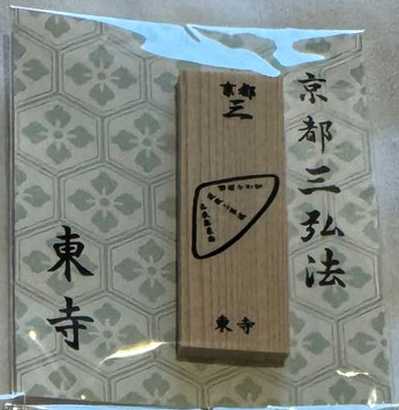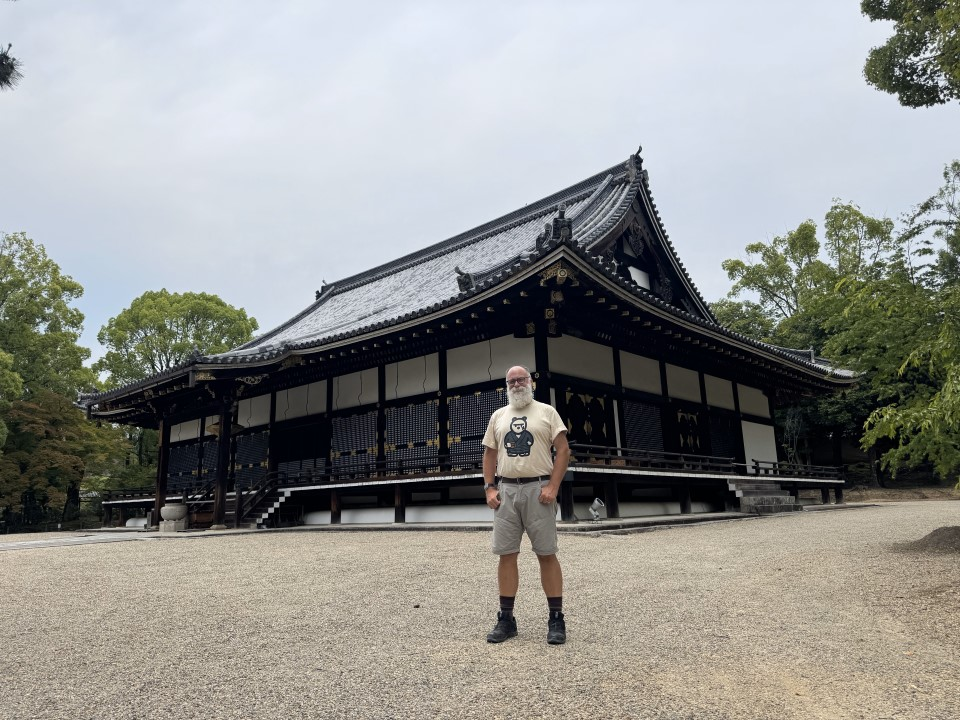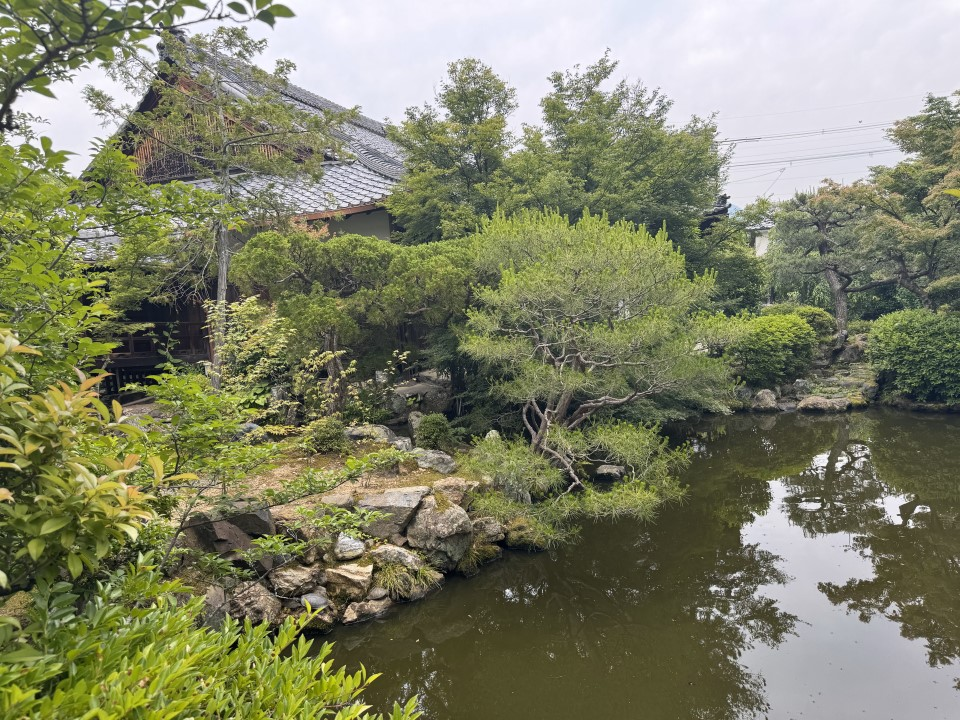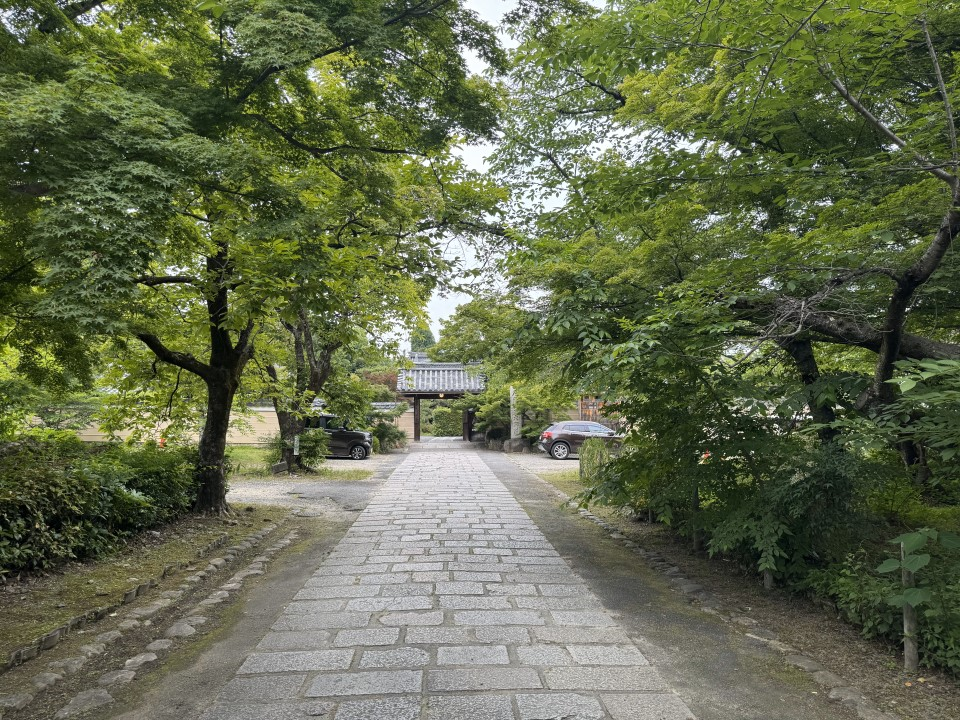Day 60: To-ji, Ninna-ji, Jinko-in (from Namba)
Look, you’re probably as surprised as I am to be getting yet another email, but hey: life’s full of surprises.
I had thought I had completed my pilgrimage when I’d received a red seal stamp from Ichijo-in in Koyasan; I was not planning on doing anything else other than hanging out in Osaka for 72 hours or so before boarding a flight home to Palm Springs. Sometimes, though, it’s good to wake up in the morning, set aside your intentions, and see where the world takes you that day.
Last night, I met the Belgian cub for one last beer at the Osaka Eagle. He, as am I, is flying out of Osaka this coming Tuesday; he’s been here in Osaka for a few days, enjoying, uh, some stuff that you do not encounter on the pilgrimage in Shikoku. Given that we met on the 2nd day of the pilgrimage, how could I pass up the opportunity to check in with him again and talk a bit about our experience, spiritual and otherwise, against a backdrop of wildly overpriced beers and bizarre Asian pop that seemingly ripped off Charli xcx in every possible way? Yeah, I’m not gonna say no to that.
Our experiences were quite a bit different; I walked most of the way, but he wasn’t able to due to injury, so he made the best of his time by hitchhiking, renting bicycles, and generally concentrating on visiting temples without worrying about the means of transportation. Me, I walked, mostly, but skipped long, boring road walks where possible; I also tried my best to take the spiritual aspects seriously, even though I’m not religious myself; I did at least go through the motions at every temple. No, I did not recite the Heart Sutra every time, but I did at least stand silently for as long as felt right before going to get a stamp.
So: I won’t go into details here, but I think we were both in agreement that although the last two months were time well spent, the Shikoku pilgrimage itself is a poor choice for walkers. The trails are few and far between; it’s mostly paved roads with traffic, which sucks. On the other hand, it’s inexpensive - outside of major cities, I often paid $50 for good lodgings with half board - and there is enough interest beyond the spiritual aspects to hold your attention.
Before I took off for the night, I met a handsome young man from Pasadena - it’s always wonderful when there’s mutual interest, what can I say - and wished the Belgian cub all the best, followed by a good, long, friendly bear hug. It felt correct.
When I woke up this morning, ever so slightly hung over and tired (mostly because the window in my hotel room is missing weather stripping, so there’s a lot of noise coming in from outside), I thought, well, what am I to do with this last full day in Japan? I had thought I’d go shopping - whisky, hiking pants, one or two small presents for friends and family - but it was too early to do that as it’s Sunday and shops weren’t open yet. Given that I’d rather be doing something other than waiting, though, I decided to get on a train and go to Kyoto instead, so I packed my bag and left the hotel… for about one minute before realizing it was raining slightly, so I went back, got my dry bag, repacked my stamp book in that, and then headed out for the day.
I’ve been researching this trip for a little over a year at this point - mostly from books, but also from a very active Facebook group for pilgrims. The common wisdom is generally that the pilgrimage entirely takes place on the island of Shikoku… but also that it’s slightly more complicated than that. In 823 C.E., Emperor Saga asked Kūkai to take over the construction of To-ji temple in Kyoto; Kobo Daishi completed the project successfully and as a result To-ji became an officially sanctioned temple, establishing Shingon as a state-approved religion and guaranteeing its success. As a result, To-ji, is Kind Of A Big Deal, Really. It also sounds like (if I understand correctly) the temple has tried to parlay its Kūkai connection into a more explicit connection with the Shikoku 88 pilgrimage, suggesting that it should be the real start of the pilgrimage and not whatever random temple on Shikoku you start at (e.g., Ryozen-ji). So, given that it isn’t explicitly the place you go when you’re done to report success and express gratitude (that’s Kūkai’s mausoleum at Koyasan), I didn’t feel like I had to go. However, for strictly secular reasons (early, bored, shops not open yet), I figured, well, what the heck. Might as well go check that out. So I did.

To-ji is a World Heritage site. It’s enormous, it’s picturesque, and apparently it’s also a great place for enormous film or TV productions. It was surreal seeing actors everywhere in period costume, complete with DPs and the police asking you to please keep moving and not to take pictures of anything. It’s also obviously a huge tourist attraction - weirdly enough, although I’ve been to Kyoto three times before, I’d never happened to visit, but the crowds of Westerners made it clear it’s hit the big time. I was feeling harried, so I just made straight for the stamp office, which was relatively quiet. The woman that helped me out was patient, charming, and we somehow managed to communicate without speaking a mutual language. She was delighted to see that I’d completed the pilgrimage and took great pains to let me know that; her calligraphy was beautiful and I was grateful that the very last stamp in my book was so beautifully done.
And then I went to the gift shop.
My partner Dan will probably be incensed - no wait, that’s a terrible pun. Uh, he’ll be probably less than enthused to know that I’ve been collecting a few small boxes of temple incense - I’ve grown a fondness for the smell, and several temples sell their own house blends (as it were) as souvenirs. I like things that smell good; I’m planning on repurposing my tea bowl as an incense burner when I get home. When a temple is a famous near-tourist trap like To-ji is, you can be sure they’ll sell incense - and given that this was the last temple of my trip, I was very, very ready to drop a lot of cash on the final mementoes of my pilgrimage. They had a nenju - kind of a Japanese Buddhist rosary - that was made of lovely wood and that matched my hakui, or pilgrim’s robe, so that was an obvious buy. They had not just one, but two different beautiful boxes of incense for sale - sold, thank you.
And then, for some reason, they had a tiny piece of wood available with a picture of my hat on it (a sugegasa, or a straw pilgrim’s hat).

At only 200 yen, how could I refuse? I bought three… and then the woman at the register started a conversation with me, again in Japanese, and again somehow I was able to understand her.
That isn’t a piece of wood with a picture of a hat on it. It’s part of an amulet, a wooden amulet - and there are two other pieces to the puzzle.
She pulled out a map and a brochure, all in Japanese, and explained where I needed to go and what I needed to do to complete the puzzle. Side quest unlocked: my quick trip to Kyoto was now a day trip.
The second temple was straightforward: Google Translate and Google Maps showed me how to get to Ninna-ji without much fuss. Another World Heritage site, it was a spectacular temple with beautiful gardens, an enormous temple, and elaborate souvenirs; I did pay for a receipt of prayers given for a friend’s medical appointment by a temple priest, for example. (And I skipped on their incense, because it didn’t smell great. Dan, you’ll thank me later for that.) And hey, friendly tourists even offered to take my picture for me!

At the main souvenir shop, the tiny wooden pieces to match the hat piece weren’t anywhere to be seen… but the shop staff’s eyes lit up when I asked them. Turns out it’s kind of a secret thing - woohoo! They happily sold me three of the second piece, the pilgrim’s walking staff. Achievement 66% unlocked! Then, I used Google Translate to ‘read’ the third temple from the map - Shinko-in, it said - and then off I went on a bus to the subway to a 1.5 km walk to get there.
After getting to the northern end of the subway line in Kyoto to start walking, I thought I’d double-check Google Maps to see if there was perhaps a bus after all - and lo and behold, there was. So I got on that bus. And about five minutes later, it didn’t feel right for some reason. Looking more carefully at the map provided by the temple, it looked like the temple was supposed to be to the west of a north-south river; where I was was to the east of a north-south river. Hmm. There were a few other things marked on the map near that third temple: a koban or police station, a park, and a shop of some kind. Google Translate wasn’t good with two of them, but the park seemed to match a park that was definitely well to the west of where I was at the moment… uh-oh. This was definitely not feeling right, and I was so far out in the north-eastern suburbs of Kyoto that I started to think I might run out of time to get to that third temple… so I got off the bus.
There’s a time and a place where taxis are worth the money, even in notoriously taxi-expensive Japan. This was a great time to get a taxi. There’s an app for that in Japan - GO or TAXI GOes Next. - and I’ll be damned but it worked: a taxi showed up in under three minutes and… the driver was as stumped as I was. He might have been Japanese, but he’d never heard of the temple, his GPS wasn’t helpful, and then together we pieced together the puzzle by finding that police station and that park and slowly realizing that although the kanji might read or sound like Shinko-in, a more correct reading would probably be something like Jinko-in. I stumbled across it on my phone while we were driving to the generally correct part of town, showed him, and then we were set. He couldn’t find the parking lot - no surprise, it turned out to be minuscule - but was happy to drop me off. Sure, that taxi ride cost me twenty bucks, but I was ecstatic.
I walked down a long, shady alley of ancient trees to a small, homely temple gate. Beyond that, a modest teahouse to the left, a discreet temple, another building that felt like an disused warehouse. A small pond, a well-worn bench, a moderate wall separating everything from the street to the east.
A pond.

Quiet.
No incense burning, no lit candles, no prayer slips, just a small box with candles and incense for sale next to a donation box.
I walked around for some time. Was this the right place? If this was the third Kobo Daishi temple in Kyoto, well, where was everyone? This was obviously not a World Heritage site; the only sign that it might be important was that the public bus stop outside was called Jinko-in-mae, suggesting it was a local landmark at the very least.
Was that a doorbell on the warehouse? Wait, was that a storeroom, possibly a residence? Well, what the heck, might as well push the button and find out what happens.
What happened was funny: it started playing the Family Mart jingle. (Whenever you enter Family Mart, the convenience store, it plays a jingle that you will remember until the end of your days.) Shortly afterwards, I could hear someone inside the building saying hello, please wait, I’m on my way. I could hear them moving behind the walls - and then I realized what I was looking at was in fact a temple office, with sliding panels that hid the window where you’d offer your stamp book up to a monk.
The monk slid the panels back with one of the friendliest smiles I’ve ever seen. I could not have been happier. I pulled out my brochure with the picture of the wooden amulet components, he smiled back, and happily sold me the final three pieces. Oh, wait, I laughed, I forgot, there’s one more piece as well, a facsimile of the pilgrimage completion certificate that goes with the three pieces - may I buy those as well? Of course! No problem. So I paid for everything.
Then, I asked, sheepishly: Do you offer goshuin? Meaning, if I give you my stamp book, will you stamp and sign that for me, please? I didn’t think it was possible for the warmth of his smile to increase, but it did. Of course. For the first time, it felt like a friend was signing my book for me; I don’t think he had much experience doing it as he had to refer to a cheat sheet, but somehow it just felt incredibly right to me. He finished; I paid. He then asked me, are you going to visit Ninna-ji next? (I assume he’d seen the stamp from To-ji and noted that there wasn’t one from Ninna-ji; this was intentional on my part as Kukai had never been at Ninna-ji, it having been founded after his death). I said no, this is my final stamp. I’m going home now. To California.
Oh, that smile. Thank you, I said. Sayonara.
I packed up my stamp book in its dry bag, put my backpack on, and turned to leave - but then went back to the temple itself for a minute.
I lit two candles for friends of mine, a stick of incense, and put the rest of my coins in the donation box. I bowed, hands in prayer, and was still for a minute before leaving.

-
I’ve enjoyed these.
Very “Memoirs Of A Geisha“ Safe trip home.
Hope to see you in January.
Bill
Add a comment: